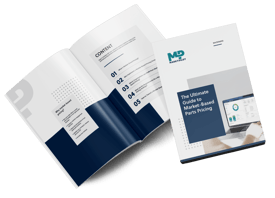AI in the Machine Manufacturing: Gearing Up for a Smart Revolution
Discover how artificial intelligence is transforming the machine manufacturing industry. The webinar review shows innovative ways of digital...
Dynamic pricing has emerged as a game-changer in the world of machine manufacturing, particularly in the pricing of spare parts.
Here, we will explore the concept of dynamic pricing, its importance in the manufacturing industry, what successful dynamic parts pricing looks like, and the essential elements for its implementation in your after-sales business.
-1.jpg)
Dynamic pricing is a strategy where the cost of a product is adjusted in real-time based on factors such as demand, market conditions, competitor pricing, and other relevant variables. In the context of machine manufacturing, dynamic pricing plays a crucial role in optimizing revenue and adapting to changing market conditions. This strategy is applied to spare parts to ensure a flexible and adaptive approach to pricing.
Monitoring competitor pricing is a critical aspect of dynamic pricing. Manufacturers continuously analyze the pricing strategies of their competitors and adjust their own prices to remain competitive.

Driving Success: Exploring the Top Parts Pricing Strategies for OEMs
In this article, we will do a deep dive into the most common pricing strategies to help you navigate which spare parts pricing strategy is best for your specific parts business.
Dynamic pricing is particularly relevant and beneficial in the context of spare parts pricing in machine manufacturing. Here are some specific reasons why dynamic pricing is important for spare parts in this industry:

Dynamic pricing allows manufacturers to maximize revenue by adjusting prices according to market demand and other influencing factors.

In the highly competitive landscape of machine manufacturing, dynamic pricing provides a competitive edge by ensuring that prices align with market dynamics and customer expectations.

Efficient pricing strategies aid in inventory management by influencing demand and preventing overstock or stockouts.

Tailoring prices to market conditions and customer needs enhances customer satisfaction and loyalty.
Strong data enables businesses to respond to rapid changes in market conditions and demand, analyze competitive pricing strategies, understand customer behavior, and adapt to fluctuations in the supply chain.
Not only is have strong data necessary for dynamic pricing, but is key to have access to analytics regarding this data.
Implementing dynamic pricing requires a sophisticated technology infrastructure to support real-time adjustments and seamless integration with existing business systems.
A team with expertise in data analysis, pricing strategies, and market dynamics is crucial for the successful implementation of dynamic pricing.
It is important to continuously monitor the market so that you can quickly adjust your pricing rules as changes occur and not give away revenue.
Successful dynamic parts pricing in machine manufacturing, specifically in spare parts, is characterized by a responsive and data-driven approach. Leveraging real-time data analysis and predictive modeling, manufacturers adapt pricing strategies to reflect changing market conditions and forecasted demand fluctuations. This agility allows them to optimize spare part prices in a way that ensures competitiveness while maintaining profitability.
Customer segmentation is a key component of dynamic pricing, enabling manufacturers to tailor strategies based on factors like loyalty and order volume. By implementing loyalty programs, volume discounts, and targeted promotions, manufacturers strengthen customer relationships and encourage repeat business. Seamless integration with e-commerce platforms further enhances the dynamic pricing strategy, ensuring consistency across sales channels and enabling rapid adjustments to prices in response to market shifts. In essence, successful dynamic parts pricing involves a strategic combination of data analytics, predictive modeling, and customer-centric approaches to navigate the complexities of the spare parts market.
To successfully implement dynamic pricing in the after-sales business, manufacturers should begin by clearly defining the objectives of their dynamic pricing strategy.
This involves a strategic alignment of pricing goals with broader business objectives. Investment in a technology infrastructure capable of supporting real-time adjustments is imperative. Continuous monitoring of market conditions is vital to making necessary adjustments to pricing strategies. Equally important is the need to cultivate a team that is well-versed in the principles of dynamic pricing, ensuring the seamless execution of pricing strategies.
Clearly outline the objectives of your dynamic pricing strategy, whether it's maximizing revenue, gaining market share, or optimizing profitability.
Implement a robust technology infrastructure that supports real-time data analysis and pricing adjustments.
Regularly monitor market conditions, customer behavior, and competitor pricing to make necessary adjustments to your dynamic pricing strategy.
One example of dynamic pricing in the context of machine manufacturing is the implementation of market-based pricing.
In this approach, manufacturers frequently analyze market conditions, competitor pricing, and demand fluctuations to adjust the prices of spare parts in real-time.
By continuously monitoring market dynamics and adjusting prices accordingly, market-based pricing exemplifies the core principle of dynamic pricing, which is to set prices in a way that maximizes revenue and reflects the current state of the market. This approach allows businesses to stay competitive, optimize profitability, and respond effectively to changes in the business environment.
Keep your finger on the pulse of the market and make informed pricing decisions based on current and reliable market data. In this guide, you'll learn how and why.


The PRICERADAR identifies opportunities in your parts pricing - realizing these potentials means adjusting prices.

Competing in today's marketplace requires a parts pricing strategy that is in line with what the market will bear...

Discover how to sustainably increase your revenue with market-based spare parts pricing.
MARKT-PILOT is a leading provider of software for market-based spare parts pricing in machine manufacturing. The solutions enable OEMs to conduct precise market price research, automated price recommendations and optimized strategies. Customers benefit from increased sales, margins and customer satisfaction in their parts business.

Discover how artificial intelligence is transforming the machine manufacturing industry. The webinar review shows innovative ways of digital...
The industry conference for aftermarket and pricing in machine manufacturing professionals is gearing up for its 2025 event.
Following Trump's announcements of sweeping global tariffs, a historic trade war is imminent in 2025. Read now how your business can remain...